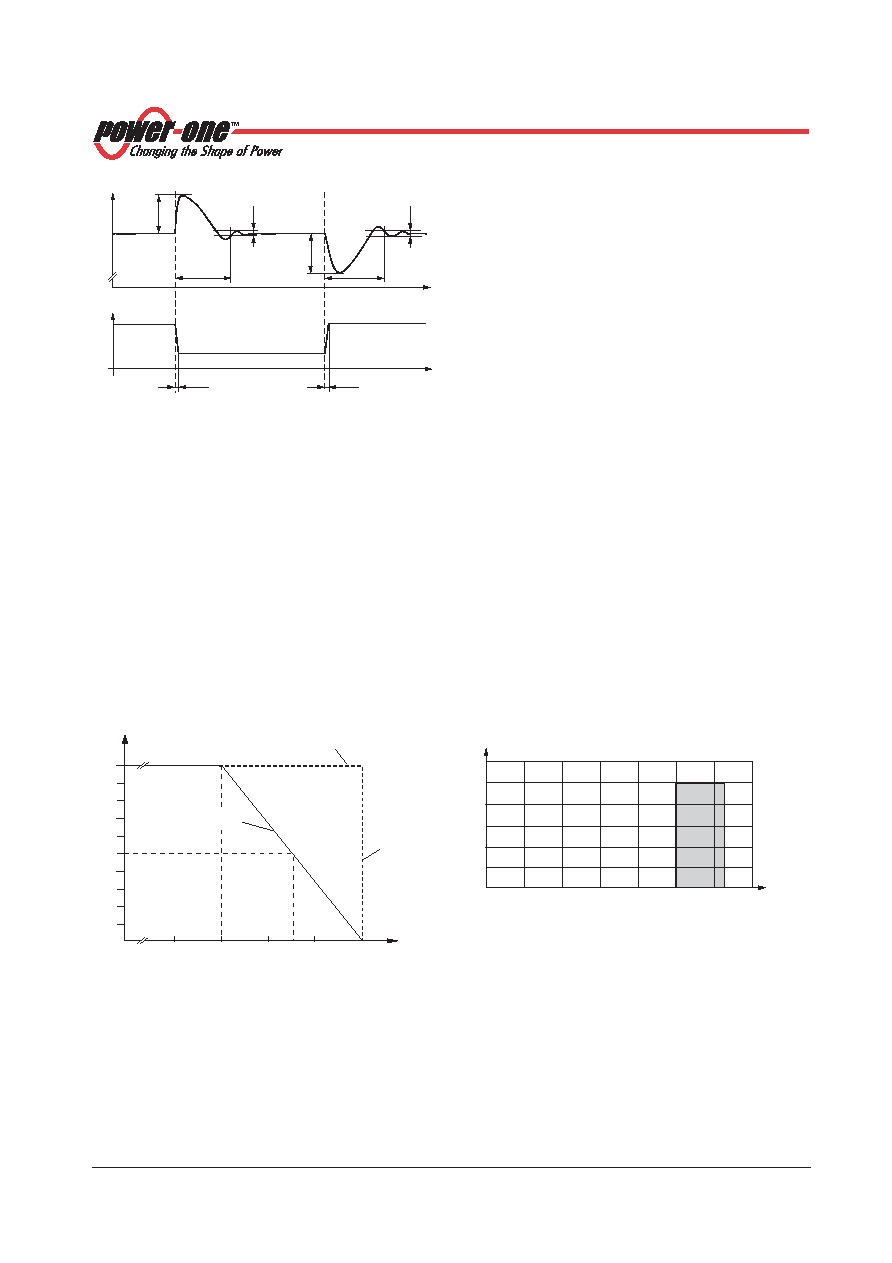- 您現(xiàn)在的位置:買賣IC網 > PDF目錄69137 > PSS2414-2B (POWER-ONE INC) 1-OUTPUT DC-DC REG PWR SUPPLY MODULE PDF資料下載
參數資料
| 型號: | PSS2414-2B |
| 廠商: | POWER-ONE INC |
| 元件分類: | 電源模塊 |
| 英文描述: | 1-OUTPUT DC-DC REG PWR SUPPLY MODULE |
| 封裝: | METAL, CASE S01, MODULE |
| 文件頁數: | 11/15頁 |
| 文件大?。?/td> | 311K |
| 代理商: | PSS2414-2B |

PSS, PSK Extended Data Sheet
Positive Switching Regulators (Benign)
REV. FEB 15, 2004
Page 5 of 15
Thermal Considerations
When a switching regulator is located in free, quasi-station-
ary air (convection cooling) at a temperature
TA = 50°C and
is operated at its nominal output current
Io nom, the case
temperature
TC will be about 80°C after the warm-up
phase, measured at the
Measuring point of case tempera-
ture TC (see: Mechanical Data).
Under practical operating conditions, the ambient tem-
perature
TA may exceed 50°C, provided additional meas-
ures (heat sink, fan, etc.) are taken to ensure that the case
temperature
TC does not exceed its maximum value of
80 °C.
Example: Sufficient forced cooling allows
TA max = 65°C. A
simple check of the case temperature
TC (TC
≤80°C) at full
load ensures correct operation of the system.
1.2
1.0
0.8
0.6
0.4
0
0.2
0.4
1.0
1.2
0.2
0.6
0.8
1.4
Vo/Vo nom
Io/Io nom
I o
no
m
Io L
05038
Fig. 4
Overload, short-circuit behaviour Vo versus Io.
0
0.1
0.2
0.3
0.4
0.5
0.6
0.7
0.8
40
60
70
80
Io/Io nom
TA [ C]
0.9
1.0
Forced cooling
05032
TC max
50
Convection cooling
TA min
Overtemperature Protection
The unit is self-protecting by an internal temperature moni-
tor, which inhibits the output above
TC max. The output is au-
tomatically enabled again after temperature has dropped
below
TC max.
Output Protection
A voltage suppressor diode which in worst case conditions
fails into a short circuit, protects the output against an inter-
nally generated overvoltage. Such an overvoltage could oc-
cur due to a failure of either the control circuit or the switch-
ing transistor. The output protection is not designed to with-
stand externally applied overvoltages. The user should en-
sure that systems with Power-One power supplies, in the
event of a failure, do not result in an unsafe condition (fail-
safe).
Parallel and Series Connection
Outputs of equal nominal voltage can be parallel-con-
nected. Use the current sharing feature (CS) for even distri-
bution of the output current. See also:
Auxiliary Functions.
Outputs can be series-connected with any other module. In
series-connection the maximum output current is limited by
the lowest current limitation. Electrically isolated source
voltages are needed for each module!
Short Circuit Behaviour
A constant current limitation circuit holds the output current
almost constant whenever an overload or a short circuit is
applied to the regulator's output. It acts self-protecting and
recovers – in contrary to the fold back method – automati-
cally after removal of the overload or short circuit condition.
Fig. 3
Output current derating versus temperature.
Fig. 2
Dynamic load regulation.
Io/Io nom
1
Vod
t d
DVo I
t
Vo
0
t
≥10 s
05010
相關PDF資料 |
PDF描述 |
|---|---|
| PSK1218-2B | 1-OUTPUT DC-DC REG PWR SUPPLY MODULE |
| PSS2414-2B1 | 1-OUTPUT DC-DC REG PWR SUPPLY MODULE |
| PSK2418-2B1 | 1-OUTPUT DC-DC REG PWR SUPPLY MODULE |
| PSK2418-2B | 1-OUTPUT DC-DC REG PWR SUPPLY MODULE |
| PSK5A18-2B | 1-OUTPUT DC-DC REG PWR SUPPLY MODULE |
相關代理商/技術參數 |
參數描述 |
|---|---|
| PSS2430 | 制造商:Velleman Inc 功能描述: |
| PSS249-7 | 功能描述:SWITCHING REGULATOR 216W 24V RoHS:是 類別:電源 - 板載 >> DC DC Converters 系列:* 標準包裝:5 系列:* |
| PSS249-9 | 制造商:Power-One 功能描述:DC/DC PS SGL-OUT 24V 9A 216W 15PIN - Bulk |
| PSS25 | 制造商:WALL 制造商全稱:Wall Industries,Inc. 功能描述:25 Watt Single Output AC/DC Power Supply |
| PSS-25-12 | 制造商:WALL 制造商全稱:Wall Industries,Inc. 功能描述:25 Watt Single Output AC/DC Power Supply |
發(fā)布緊急采購,3分鐘左右您將得到回復。